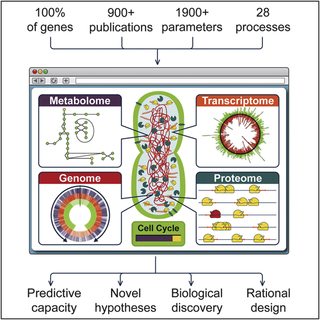For the first time created a computer model of a living cell.
 Scientists at Stanford have made a huge step forward: the first full digital model of the organism and its entire life cycle was created. To create a computer model of the tiny bacterium Mycoplasma genitalium, it was necessary to write 28 independent modules interacting with each other, simulating the processes of a living cell and operating with 1.900 parameters. 900 different scientific reports were used to describe their behavior. The complexity of the model is high: only for the process of dividing the unicellular takes 10 hours of simulation, and the output is half a gigabyte of data.
Scientists at Stanford have made a huge step forward: the first full digital model of the organism and its entire life cycle was created. To create a computer model of the tiny bacterium Mycoplasma genitalium, it was necessary to write 28 independent modules interacting with each other, simulating the processes of a living cell and operating with 1.900 parameters. 900 different scientific reports were used to describe their behavior. The complexity of the model is high: only for the process of dividing the unicellular takes 10 hours of simulation, and the output is half a gigabyte of data.Mycoplasma genitalium is a simple parasite that lives in the urinary and respiratory tract. The bacterium attracts researchers primarily by the size of its genetic apparatus - M. genitalium has only 525 genes, while the more traditional laboratory E. coli have 4.288. Despite the nature of the microorganism and the difficulty in working with the parasite, a small number of genes makes it attractive for bioengineers: it was with the participation of M. genitalium in 2008 that the artificial chromosome was first created .
The purpose of this experiment was, as Jonathan Carr, a postgraduate student in biophysics at Stanford University, says, not to analyze the processes of M. genitalium, but to improve the understanding of biology in general. The report describes the operation of the model, for example, for the dynamics of the DNA binding protein and the determination of the functions of new genes. Scientists have noticed that although the duration of individual developmental stages varies from cell to cell, the total period of the organism’s existence is almost constant, as it is supposed, because of the built-in mechanism of negative feedback.
')
Over the past two decades, much more information about the structure of the cell structure has appeared, but all experiments are reduced to replacing a single gene and observing the results. What could not be done with a real organism will allow it to produce a computer model. The need for such digital calculations is due to the fact that each gene does not simply regulate a trait, many traits are the result of the interaction of hundreds and thousands of genes. It is difficult to understand how something functions, if you do not have a reconstructed scheme of its work.
The future of such studies promises the emergence of individual gene medicine and bio-CAD, packages of biological computer-aided design, which will help to avoid the trial and error method that is used now because we do not fully understand the processes of even the simplest organism.
Science Direct Publication
Source: https://habr.com/ru/post/148198/
All Articles